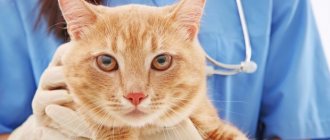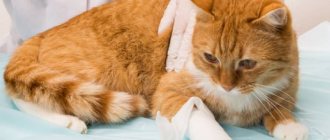Every owner certainly tries to monitor the well-being and health of their pet. Of course, the appearance of neoplasms of unclear nature raises a lot of questions and suspicions.
Lumps that can form on a cat's body or subcutaneous lumps can be malignant or benign. They may cause discomfort to your pet or may not bother the cat at all, but in any case, this is a reason to pay attention to the pet’s health and consult a veterinarian.
Cancerous degeneration of the mammary glands
Let's start with the most terrible diagnosis. How can you avoid a sad outcome? It has long been known: if you detect trouble at the very beginning!
Breast cancer is recognized by this sign: the tumor grows quickly, and there is usually more than one of it, because “trouble never comes alone”: the number of smaller swellings also increases quickly, and the localization sites at first are near the nipples closer to the groin.
These warning signs are a reason to run to the vet!
Then the bumps become dense, bleeding, painful, with a purple-pink tint. The photo shows a severe case, but don’t worry, it can be eliminated:
Since at the beginning of the disease the cat’s health is normal, as the disease progresses, it will begin to lose weight and lose appetite, and this is the second threatening “marker”! Therefore, in order not to start a tumor, to successfully get rid of it and thereby save the life (!) of your pet, you need to examine and feel its body more often in order to see a doctor early.
The photo shows the view after a successful operation:
Treatment, even in an advanced form, sometimes (but not always!) helps to prolong life by several months and reduce discomfort in this condition.
At risk are older and unsterilized animals (who are given “Sex Barrier” and all other anti-estrus drugs, the instructions for which always (!) contain a warning about the danger of oncology, even from several uses - from 1 to 3 times!).
Veterinarian advice: you need to sterilize your ward at 11-12 months, when the genitourinary system has formed, or between the first and second estrus, first having received the necessary vaccinations, and from the age of 6 - regular examination in the form of medical examination for early diagnosis of cancer, if it decides to start in your tail!
Causes and risk factors
Like people, cats age; many processes in the body begin to proceed less quickly and correctly. The likelihood of any disease, including neoplasms, increases as a result of the natural aging process.
The older the cat, the greater the risk of getting sick.
In addition, risk factors include:
- living in an area with unfavorable environmental conditions;
- hereditary predisposition;
- insufficient or poor quality nutrition;
- parasitic infestations;
- mechanical damage;
- insect bites;
- the animal has allergies;
- health problems, certain pathologies;
- immunodeficiency state.
There can be many potential reasons for the development of a pathological process, manifested by the appearance of a subcutaneous lump in an animal. It is very difficult for the owner to determine what exactly is happening to the cat. It is best to show the animal to a specialist.
Benign tumor
This is a lipoma (or wen). It is enclosed in a capsule, has clear boundaries and, unlike malignant tumors, does not tend to grow quickly, is round or oval, soft to the touch, and moves under the skin.
It is usually monitored, and if removed, it is only in extreme cases - for example, if it is too large, interferes with the cat's daily activities, or is itchy. Although it is not fatal, it is necessary to show it to a doctor to confirm this particular diagnosis:
Associated symptoms
Apart from the presence of a lump under the skin, the animal may not show any other symptoms. Wen and benign neoplasms, as a rule, do not manifest themselves in any way.
In some cases, the tumor constantly increases in size, as a result a large lump grows and begins to interfere with the cat and cause inconvenience. In such cases, measures should be taken as soon as possible.
Firstly, the rapid growth of a tumor is a dangerous sign. And secondly, the cat will try to get rid of the irritating factor by scratching or trying to rip off the bump in some way. This can lead to aggravation of the pathological process, injury, and bleeding from the damaged area.
In some cases, when a cat develops a gradually enlarging lump under the skin, a number of additional symptoms are observed. Suppuration or an inflammatory process may be accompanied by hyperemia of the affected area, skin tension, swelling and severe pain. Also, due to the activity of pathogenic microflora, symptoms of intoxication increase: fever, weakness, and sometimes nausea and vomiting.
Allergic reactions can be accompanied by extremely unpleasant itching sensations for the cat. Itchy skin provokes scratching, damage to the skin and aggravation of the problem.
Hernia
This unpleasant pathology lies in the fact that parts of the internal organs of the peritoneum penetrate into adjacent cavities through natural or abnormal openings. Both adult cats and their babies can suffer from it!
Let's start with umbilical hernia in kittens. Here it is clearly visible on the belly of the baby sphinx:
Through an umbilical ring that is not completely closed (due to genetic disorders or improper cutting of the umbilical cord), a loop of intestine falls into the “hernial sac”:
This hernia in the Sphinx is reducible. But only if it is not pinched! Otherwise, the blood flow in it is disrupted, which will cause tissue death (!), then inflammation in the peritoneum, which will turn into peritonitis, then the cat will die.
Sometimes a kitten’s hernia does not fall out immediately, but will be triggered later, for example, by constipation.
In adults, the tumor is most often located in the groin area, has a size from a small lump to an egg-shaped lump, can be soft or hard, and has a body temperature or higher.
Formed recently, it can go unnoticed for some time, because it does not yet cause anyone any discomfort, but in its neglected state it is a rather large, round swelling, soft or elastic to the touch.
The situation is worse if the hernia is pinched, then the cat will feel constant pain, often meow, cower, arching its back. There will be problems with stool and urination, sometimes vomiting, fever, lethargy, and possible disturbances in gait and coordination. Surgery is inevitable!
Predisposed animals are those with:
- genetic inheritance;
- digestive problems: constipation and increased gas formation;
- cutting the umbilical cord too short;
- peritoneal injuries: blows, bruises, bites, etc.
Of course, you cannot “treat” yourself with decoctions, compresses, set internal organs, or wait until “it goes away on its own”!
Only a specialist can make the correct diagnosis, perhaps with the help of an x-ray or ultrasound. And after the reduction, a bandage will be put on the pet for 3-4 weeks to prevent relapses.
You can do without surgery if the tumor is small, but you will have to eliminate it if it is diaphragmatic or intervertebral. And then the following are prescribed: immunomodulatory and anti-inflammatory drugs; a diet that eliminates constipation; ban on active games for 2 weeks.
Treatment depending on the cause of the appearance of the ball under the skin
Mammary cancer in a cat: breast tumor
If a neoplasm is noticed in an animal, it is necessary to contact a veterinarian. The tumors are removed; no ointments can help with their treatment. If the lump is due to suppuration, it is opened and washed with a disinfectant solution.
When a hernia appears, it is removed with massage or a tight bandage. In extreme cases, surgical removal is resorted to.
Lipoma is rarely removed; in most cases it is treated with ointments and other medications.
Mastitis responds well to treatment with compresses and antibiotics. Sometimes massage is used. For mastitis, a novocaine blockade, physiotherapy, and, in extreme and advanced cases, surgery are also often prescribed.
Cancerous formations are treated with chemotherapy, and then surgery is performed with further removal. It is important to pay attention to whether metastases have occurred, so as not to waste time and take the right treatment tactics.
As for benign formations, if they are small in size and do not bother the animal, surgical intervention is not required. When a soft lump appears on a kitten’s stomach, as a rule, this is a benign neoplasm; conservative treatment methods are most often prescribed.
Benign tumors can be treated with medications
Subcutaneous tumors, such as abscesses and cysts, are treated conservatively, but they cannot be neglected. The specialist washes and treats the area with furatsilin and hydrogen peroxide. In the most difficult cases, additional antibiotics are prescribed. At home, it is better not to squeeze pus out of wounds, as it can enter the bloodstream, and, as a result, blood poisoning or a recurrent abscess will begin. Moreover, there is no need to wait for the abscess to open on its own.
Cysts can form due to clogging of the glands, they can be filled with sebum-like contents, and they can be follicular.
For lymphadenitis, the cat is prescribed medications that eliminate inflammation in the lymph nodes.
For infectious bumps, antibiotics and anti-inflammatory drugs are prescribed.
In case of allergies, the cause is determined, antihistamines are prescribed and the factor that provoked the reaction is eliminated.
If a decision has been made to undergo surgery, then after the operation the animal is prescribed a course of antibiotic therapy, immunomodulators, and if we are talking about a malignant tumor, then a course of chemotherapy.
Mastitis
It is a consequence of early weaning from a nursing mother, sometimes - diseases of the genital organs, damage to the nipples or false pregnancy.
The mammary glands become inflamed and swollen, become hard and hot, and the body temperature rises. This is what a Sphynx cat looks like:
If a nursing female is sick, milk may not be released or will come along with pus. The doctor, after the necessary tests, will make sure that there is no cancer and will prescribe treatment.
If the illness is mild, he will prescribe compresses and massages at home; if it is severe, he will prescribe medications, including antibiotics, or even surgery.
Skin pathologies
A lump on a cat's stomach may be one of the skin diseases that are divided into benign and malignant. The first group of ailments includes :
- Boils are inflammatory processes in the hair follicle. The lump is small and painful at first. Over time, it increases to 1-1.5 cm due to the accumulation of pus. At the final stage it is opened. Pus flows out.
- Folliculitis is an inflammatory lump with pus. It is a small nodule on the abdomen. It develops due to ingrown hairs, the skin around which turns red and swollen.
- A carbuncle is a lump covered with multiple blisters containing purulent fluid.
- An abscess is an inflammation resulting from a bacterial infection that has gotten under the skin. Pus accumulates in a limited cavity. Spread of infection to adjacent areas is rare. Sometimes it does end up in the blood or lymph. An abscess lump is usually painful. Often accompanied by an increase in temperature.
- Phlegmon is a diffuse purulent inflammation. The lump is very painful. The skin over it is red.
Treatment of benign neoplasms on a cat's abdomen is usually conservative. Therapy includes ointments, creams and other similar products for external use. Surgery is very rarely required.
Malignant lumps on a cat's abdomen grow rapidly. They are dense, covered with bumps and ulcers. Skin necrosis is observed in some areas of the tumor. The seals are movable. Treatment is surgical. The prognosis depends on the stage.
Hygroma
Or a synovial cyst is a swelling of tissue with saturation with serous fluid.
It looks like a painless swelling with fluid inside, but if an infection joins it, ulcerations and discharge appear. And when it grows to a large size, it can interfere and hurt when moving.
The veterinarian may prescribe removal of the contents of the cyst and the introduction of anti-inflammatory drugs in its place, but surgery is rare.
Furuncle
This is not just an abscess - inflammation of the epithelium, but a disease (in acute or mild form) caused by decreased immunity and focal damage to the hair follicle. It is purulent and necrotic in nature, caused by white or aureus staphylococcus, and begins with a red tubercle:
Gradually, the sore increases, fills with pus, becomes painful, body temperature rises, apathy and loss of appetite are possible. The lesions affect some or all parts of the body, or isolated ones.
Under the skin, the pus is located, as it were, in a “vessel” that restrains the boundaries of inflammation, and after “ripening” one (or several) gray dots will be visible from above - the rod.
Do not squeeze out the boil! Otherwise, the pus will spill over the adjacent tissues.
The veterinary clinic will do everything you need, and in the case of a chronic form, they will prescribe antibiotics.
Keep a sick animal especially clean by placing disposable diapers on top of the bedding every day. Don't bathe! Trim the fur from the site of inflammation, apply ichthyol ointment or Vishnevsky, wipe with alcohol while changing the compress, give an anesthetic. In case of spontaneous opening of the sore, clean it as much as possible from pus (do not press!) and reapply a bandage with ointment, changing it every 4-6 hours until the wound is completely cleansed.
Abscess
This is a localized inflammation on the surface of the skin or deep in the tissues that can seriously threaten your pet's health if left untreated.
The most common causes are infection in wounds received by the cat in a variety of ways, which is why you can find swelling (with a purulent capsule inside) anywhere.
At this stage of edema and suppuration, urgent qualified help is needed, otherwise there is a risk of blood poisoning and death.
And we have all known prevention since childhood: immediately wash and disinfect any wounds that arise! How? Peroxide is better, others will cause a burn.
Insect bite
No, not butterflies. Painful swelling can only be caused by the bite of stinging insects!
Remove the sting with tweezers, rinse with a soda solution (a teaspoon per glass of water) and apply a cold compress to relieve swelling.
To prevent allergies, give ¼ tablet of Tavegil or Suprastin twice a day, and if the condition worsens, go straight to the clinic, and even more so if there are a lot of bites, because then death is not far away.
Lymphadenitis in cats
A lump may appear on a cat's stomach if the inguinal lymph node becomes inflamed. The cause is an infection leading to diseases of the genitourinary system. With lymphadenitis, compaction is characterized by the following features :
- oblong shape;
- soreness;
- immobility;
- the skin over the bump is hot.
If such a tumor is discovered, the cat should definitely be shown to the doctor. The disease that causes lymphadenitis requires treatment. Antibiotics, anti-inflammatory drugs, preparations with vitamins, iron, magnesium, potassium and other beneficial substances that help strengthen the immune system may be indicated.
Symptoms of lymph node inflammation are similar to cancer. Cancer can only be ruled out by diagnostics, so a trip to the clinic is essential.











